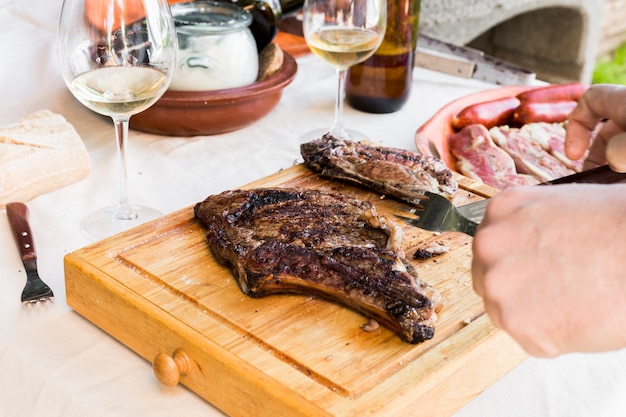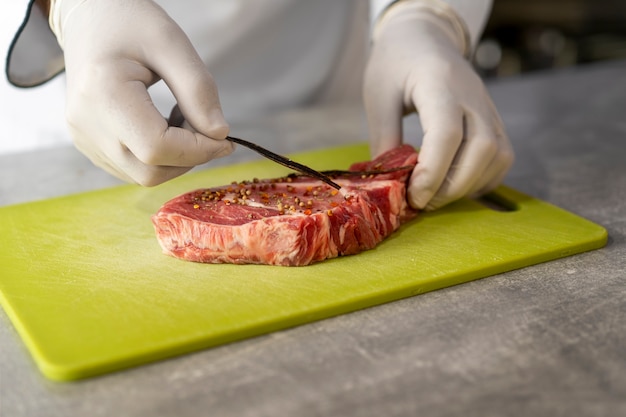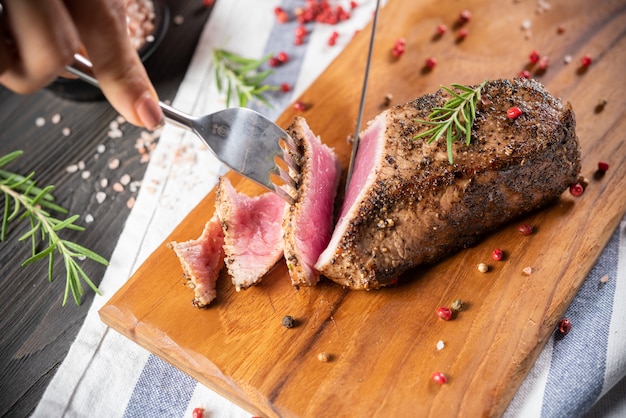Ah, flank steak. It's a cut of beef that's often overlooked, dismissed as too tough, too chewy, too much of a hassle. But let me tell you, with a little love and attention, flank steak can transform into a culinary masterpiece.
I've been on a flank steak journey myself, one filled with trial and error, burnt edges, and a few dry, disappointing meals. But I kept at it, determined to unlock the secrets of this unique cut. And, oh boy, it was worth it. Now, I find myself grilling up flank steak with confidence, knowing each bite will be juicy, flavorful, and tender.
This isn't just a guide; it's a celebration of flank steak. It's an invitation to embrace the challenge and discover the incredible potential this cut holds. Get ready to explore the secrets of choosing the perfect flank steak, mastering the art of preparation, and conquering the grill to achieve that perfect sear. We'll delve into marinades, resting times, and the most delicious ways to serve this culinary gem. Let's get started!
(Part 1) choosing the right cut: The Foundation of a Great Steak

Flank Steak: A Cut Worth Getting to Know
Flank steak comes from the abdominal region of the cow, a muscle that's worked hard, giving it its unique texture and intense flavor. It's a long, thin cut with a distinct grain, running the length of the steak. This grain is a key element to consider when prepping and cooking, as it holds the key to achieving that tender, melt-in-your-mouth texture.
Flank Steak vs. skirt steak: Understanding the Difference
You might hear "skirt steak" and "flank steak" tossed around like they're interchangeable, but they're actually two distinct cuts. Skirt steak, coming from the diaphragm, is shorter and wider than flank steak. Both are delicious, but flank steak tends to be a bit leaner and generally considered more tender, making it a favorite among grill enthusiasts.
Spotting the Perfect Flank Steak: What to Look for
Finding a top-notch flank steak starts at the butcher counter. Here's what to keep an eye out for:
- Marbling: Look for a steak with a good amount of marbling, those streaks of fat that add flavor and keep the steak moist during cooking. Think of it like a sprinkle of extra flavor and moisture throughout the cut.
- Freshness: A bright red colour is a sign of freshness. Avoid any steak that appears brown or dull. It should also feel firm and not slimy to the touch.
- Thickness: Aim for a steak that's around 1 inch thick. This allows for a beautiful sear on the outside while keeping the inside juicy and cooked evenly.
(Part 2) The Art of Prep: Unlocking the Potential

Cutting Against the Grain: The Key to Tenderness
Let's talk about the grain. It's the reason why flank steak can sometimes be tough if you're not careful. You see, those muscle fibers run the length of the steak, creating a long, sturdy structure. If you cut with the grain, you're slicing through those fibers, resulting in a chewy bite.
Here's the secret: cut against the grain. Imagine slicing your steak across the direction of those fibers. This creates shorter, more tender pieces of meat, resulting in a melt-in-your-mouth experience. Don't worry, we're not slicing the whole steak before grilling – that would lead to a dry steak. We'll slice against the grain after grilling, enjoying those perfectly tender bites.
Marinating Magic: Infusing Flavor and Tenderness
Marinating is a key element in transforming flank steak from ordinary to extraordinary. It does more than just add flavor; it helps tenderise the meat, making those tough muscle fibres more manageable.
The trick is to keep it simple. A classic blend of olive oil, lemon juice, garlic, and herbs is all you need to create a marinade that's both flavorful and effective. The acid in the lemon juice breaks down the proteins, while the olive oil and herbs add a symphony of aromas and tastes.
My Go-To Flank steak marinade: A Taste of My Experience
Over the years, I've refined my marinade, and this is what I've come to love:
- 1/4 cup olive oil – a base for the marinade, adding richness and flavor.
- 1/4 cup lemon juice – the key to tenderizing, bringing a bright acidity that helps break down the proteins.
- 2 cloves garlic, minced – adds a pungent, aromatic punch that complements the beef beautifully.
- 1 tablespoon chopped fresh rosemary – brings a touch of earthiness and a hint of pine.
- 1 tablespoon chopped fresh thyme – offers a delicate floral aroma and a slightly peppery taste.
- 1 teaspoon salt – enhances the natural flavors of the steak and helps to create a flavorful crust during grilling.
- 1/2 teaspoon black pepper – a touch of spice that balances the other flavors.
Combine all the ingredients in a bowl, then add your flank steak. Make sure it's completely submerged in the marinade. Cover the bowl and refrigerate for at least 2 hours, or better yet, overnight. This gives the flavors time to penetrate the steak and allows the acid to work its magic.
(Part 3) Grilling to Perfection: Embracing the Heat

The Grill: Your Partner in Flavor
Now, we get to the fun part: grilling! And for flank steak, I always recommend a high heat, about 450-500°F. This intense heat creates a beautiful sear on the outside, locking in the juices and giving the steak a wonderful crust.
Why Hot is the Way to Go: The Power of High Heat
Think of it this way: a hot grill creates a quick sear, allowing the steak to cook efficiently and evenly. If you grill over low heat, the steak will cook slowly, potentially leading to dryness. High heat is your friend, giving you a juicy, flavorful result.
Grilling Technique: A Recipe for Success
Here's a simple grilling technique that has always worked for me:
- Get that sear: Let the steak cook for about 3-4 minutes per side over high heat. You're aiming for a nice, crisp char. It's the first step in a beautiful grilling journey.
- Lower the heat: After that initial sear, reduce the heat to medium-low (about 250-300°F). This allows the steak to cook through more gently, ensuring a tender, juicy center.
- Cook to your preference: Continue cooking for another 5-7 minutes, flipping once or twice, until the steak reaches your desired doneness. Use a meat thermometer for accuracy.
Remember, flank steak is best cooked to medium-rare or medium. Overcooking will make it tough and dry. The goal is a steak with a beautiful char on the outside and a juicy, flavorful center.
(Part 4) Resting: Giving the Steak a Moment to Relax
Why Resting Matters: A Crucial Step
After the grilling excitement, it's time for a bit of patience. Let your steak rest for 10-15 minutes before slicing it. This crucial step allows the juices to redistribute throughout the steak, creating a more tender and flavorful result.
The Resting Process: A Time to Prepare
While the steak is resting, it's a great opportunity to prepare your sides. It's also a good time to clean up your grill and wash your hands. Resist the urge to touch the steak during this crucial resting period. Let those juices settle in for a truly satisfying outcome.
(Part 5) Slicing and Serving: A Culinary Celebration
Cutting Against the Grain: Finalizing the Texture
Now, it's time to unveil the fruits of your labor. Remember the grain we discussed earlier? Well, slicing against the grain is the final step in ensuring a tender, delicious bite. Slice the steak into thin strips or thicker pieces, depending on your preference. It's a satisfying moment to see those beautifully cooked slices, ready to be enjoyed.
Serving Up the Flavors: Endless Possibilities
Flank steak is incredibly versatile. Here are a few ideas to get your creative juices flowing:
- Tacos: Slice the steak into thin strips and serve it in warm tortillas with your favorite toppings like salsa, guacamole, sour cream, and shredded cheese. It's a fiesta of flavors in every bite!
- Grilled Salad: Toss the steak with a fresh salad of greens, tomatoes, cucumbers, and onions. Drizzle with a light vinaigrette for a refreshing and satisfying meal.
- Steak Sandwiches: Serve the steak on toasted bread with your favorite toppings like grilled onions, peppers, and cheese. It's a simple yet satisfying sandwich that's perfect for a casual lunch or dinner.
- Stir-fry: Slice the steak into thin strips and toss it with your favorite vegetables and sauce for a quick and flavorful stir-fry. It's a great option for a weeknight meal that's full of flavor and nutrition.
(Part 6) The Art of Flavour: Sauces and Toppings
Elevating the Experience: Adding Flavorful Accents
A good sauce can elevate flank steak to a whole new level. Here are a few sauces that complement the flavor profile beautifully:
- Chimichurri: This Argentinian sauce is a symphony of fresh herbs, olive oil, vinegar, and garlic. It's the perfect way to add a bright, tangy flavor to grilled flank steak.
- Salsa Verde: This Mexican sauce, made with tomatillos, cilantro, jalapeno peppers, and onions, is a delicious and refreshing topping for flank steak tacos.
- Red Wine Reduction: A simple red wine reduction, made with shallots, garlic, and herbs, can really enhance the flavor of flank steak. It's a classic pairing that adds depth and richness.
Beyond the Sauce: Toppings for Every Taste
If you're looking for something more than a sauce, here are a few topping ideas:
- Grilled Onions and Peppers: Grill some onions and peppers until they're caramelized and serve them over your flank steak. This combination is a classic for a reason.
- Avocado Slices: The creamy richness of avocado complements the flavor of flank steak perfectly. It's a touch of elegance that adds a smooth, buttery texture.
- Grilled Pineapple: Add a touch of sweetness and acidity to your flank steak with grilled pineapple slices. It's a delightful combination of sweet and savory.
(Part 7) cooking tips and Tricks: Avoiding Common Mistakes
Overcooking: The Enemy of Tenderness
Overcooking is the most common mistake when it comes to flank steak. Remember, it's best cooked to medium-rare or medium. Overcooking will result in a tough, dry steak. Resist the urge to cook it too long, and trust your thermometer.
Don't Flip It Too Often: Respect the Cooking Process
Another common mistake is flipping the steak too often. Flipping it every minute will disrupt the cooking process, leading to uneven cooking. Flip the steak once or twice during grilling, allowing it to cook consistently on each side.
Let it Rest: A Crucial Step for Juicy Flavor
And finally, always remember to let the steak rest after grilling. It's a critical step in allowing the juices to redistribute throughout the steak, resulting in a more tender and flavorful experience.
(Part 8) Beyond the Grill: Exploring Other Cooking Methods
Flank Steak: A Versatile Culinary Star
While grilling is my favorite way to cook flank steak, it's a versatile cut that's perfect for other cooking methods.
Pan-Seared Perfection: Quick and Flavorful
For a quick and easy weeknight meal, try pan-searing your flank steak. Heat a heavy-bottomed skillet over high heat, add a little oil, and sear the steak for 3-4 minutes per side. Then, reduce the heat to medium-low and cook for another 5-7 minutes, or until it reaches your desired doneness.
slow cooker Comfort: Tender and Flavorful
Flank steak can also be cooked in a slow cooker, for a tender and flavorful meal. Simply brown the steak in a skillet, then place it in the slow cooker with your favorite sauce and vegetables. Cook on low for 6-8 hours, or until the steak is fork-tender.
(Part 9) FAQs: Answering Your Flank Steak Questions
How Long Should I Grill Flank Steak?
The grilling time will depend on the thickness of your steak and your desired doneness. For a 1-inch thick flank steak, you can expect to grill it for about 8-10 minutes total, flipping it once or twice. Use a meat thermometer to check the internal temperature. A medium-rare steak will be around 130-135°F, and a medium steak will be around 140-145°F.
How Do I Tell if Flank Steak is Done?
The best way to tell if flank steak is done is to use a meat thermometer. However, you can also check the steak's color and texture. A medium-rare steak will have a deep reddish-brown colour, and the juices will run clear. A medium steak will have a slightly browner colour, and the juices will be a little pink.
Can I Marinate Flank Steak in Advance?
Yes, you can absolutely marinate flank steak in advance. In fact, it's highly recommended. Marinating the steak for at least 2 hours, or even overnight, will allow the flavors to penetrate the meat and make it more tender.
What are Some Good side dishes for Flank Steak?
Flank steak goes well with a variety of side dishes. Some of my favorites include grilled vegetables, roasted potatoes, mashed potatoes, couscous, and salads.
Can I Freeze Flank Steak?
Yes, you can freeze flank steak for up to 3 months. Wrap it tightly in plastic wrap and then place it in a freezer-safe bag. When you're ready to use it, defrost the steak in the refrigerator overnight.
(Part 10) Final Thoughts: A Love Affair with Flank Steak
There you have it, my friends – my ultimate guide to grilling flank steak. It's a journey that started with frustration and evolved into a deep appreciation for this delicious cut of beef. Now, I can confidently say that grilling flank steak is one of my favorite things to do.
The flavor is incredible, the tenderness is undeniable, and the possibilities for serving it are endless. So, go forth, grill masters, and embrace the delicious world of flank steak!
Everyone is watching

How to Cook Frozen Lobster Tails Perfectly: A Step-by-Step Guide
RecipesLobster. Just the word conjures up images of lavish meals, special occasions, and a taste of luxury. But let's...

Pork Fillet Cooking Time: How Long to Cook It Perfectly
RecipesPork fillet, or tenderloin as it's sometimes called, is a real favourite in our house. It's so versatile, and...

Pigs in a Blanket Cooking Time: How Long to Bake for Perfect Results
RecipesAh, pigs in a blanket. Just the name conjures up images of those delightful little parcels of crispy pastry en...

The Ultimate Guide to Cooking Delicious Frankfurters
RecipesLet's face it, we all love a good frankfurter. It's a classic, simple, and always satisfying. But let's be rea...

Wolf Meat Recipes: A Guide to Cooking Wild Game
RecipesLet's be honest, you don't see wolf meat at your local butcher shop every day. It's a bit of a wild card, but ...
